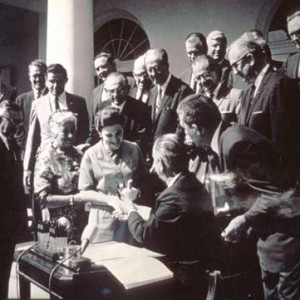Fifty years ago this week, President Lyndon Johnson signed into law the Wilderness Act, supported by nearly everyone in Congress, from both houses and both parties. Nine million acres were allotted to the National Wilderness Preservation System. Often adjacent to national parks, they included a variety of exceptionally beautiful places, including mountains, deserts, forests, and lake environments.
According to Congress, wilderness was “for the use and enjoyment of the American people,” but they must be willing to walk, canoe, or ride horses. Motorized vehicles, motorboats, and even bicycles were excluded. Since 1964 another 100 million acres have been added to the system so that, by now, over four percent of the whole United States, an area as big as California, is designated wilderness.
The Wilderness Act was a superb achievement. It assured the future of amazing recreational areas, protected endangered plant and animal habitats, and discouraged rural sprawl. Yet it has never lacked for critics, and the justifications offered for its extension are not without their oddities and paradoxes.
First, Congress defined wildernesses as areas retaining their “primeval” character, implying that no one had ever lived there and never would. Actually, many of the designated areas had been Native American lands whose inhabitants had been forced out by white soldiers, miners, and ranchers in the nineteenth century. The Indians had lived there for centuries and modified the land by fire, hunting, and farming. It became “wilderness” only because the federal government said so, not because of its intrinsic wildness.
Second, the idea of wilderness as something to celebrate was recent. In the colonial era “wilderness” was bad, not good. When the Pilgrim Fathers described their new home as a wilderness, they were comparing it to the harsh places where the Children of Israel wandered after their escape from slavery, and where Jesus was tempted by the Devil. It was the abode of wild animals and wild people, fearsome rather than lovable. Only in the late nineteenth century did John Muir and others, influenced by Romanticism and Transcendentalism, begin to voice the idea that wilderness was precious and edifying. Muir depicted humans, not wild animals, as the worst predators.
Third, the rhetoric of wilderness advocates has usually emphasized that setting aside these lands is democratic, and that everyone benefits. Not really. The several million people who actually enjoy wilderness areas each year are nearly all white and upper middle class. Only they have enough leisure and wealth. This is most true in the state that contains the most wilderness areas: Alaska. The rules may encourage the idea of the simple life, and specify quiet, organic movement, but wilderness depends on high-tech devices: you can’t even get to them without cars, planes, and plenty of money.
The people who live beside the wilderness areas often resent the fact that these areas have been—as they see it–“locked up” by self-interested elites, while excluding poorer folks like themselves from the chance to work there and the right to ride their dirt bikes, ATVs, and motorboats. The Sagebrush Rebellion of the late 1970s, and the “Wise Use” movement of the 1990s were both protests against what they perceived as the elitism of federal land policy in general, and the Wilderness Act in particular.
Fourth, the language of the Act and (sometimes) the language of wilderness advocates encourages the idea that wilderness is good because it is the antidote to civilization. The website “wilderness.net,” for example, describes wilderness areas as “rare wild places where one can retreat from civilization, reconnect with the Earth, and find healing, meaning, and significance.” The implication is that civilization is wounding, meaningless, and insignificant. The Wilderness Society’s website claims that wildernesses are necessary, and that urban children suffer from an ailment it describes as “nature-deficit disorder.”
The historian William Cronon poured cold water over such claims in “The Trouble With Wilderness” a New York Times Magazine article from 1995. Wilderness areas are one of the creations of our civilization, he pointed out, not its antithesis. He also warned against a form of dualism in thinking about land use: to honor some lands as wildernesses, and to link their specialness to the absence of people, implicitly denigrates urban areas, where nearly all Americans actually live. Wouldn’t it be better, he asked, to encourage a more responsible attitude to all environments, urban and rural, and to emphasize their interconnections?
Despite criticisms from left and right, and activists’ anxiety that not enough lands have been designated, the National Wilderness Preservation System is alive and well. It is more than a thousand percent bigger than it was when the Wilderness Act was passed. Increasing our national wealth in the decades since 1964 has not required us to sacrifice areas of exceptional beauty. On the contrary, it has made preserving more of them possible, which holds out a distinctly hopeful prospect for the System’s next half-century .

